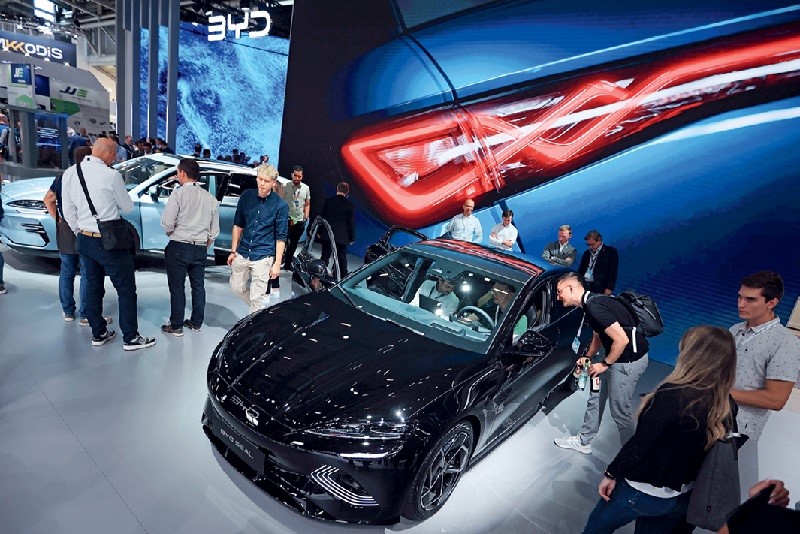China’s new policies and new expo ahead of the China-EU summit strengthen both economic and people-to-people links.
A recent report and an important event deserve the attention of policy makers globally, coming on the eve of the EU-China summit in Beijing (December 7-8) ahead of an uncertain new year. The document was released by the Office of the Leading Group for Promoting the Belt and Road Initiative (BRI) on November 24, spelling out the vision and actions for high-quality Belt and Road cooperation in the next decade. The event was the first China International Supply Chain Expo and the Global Supply Chain Innovation and Development Forum, inaugurated in Beijing on November 28, the first of its kind globally. The five-day expo, themed “Connecting the World for a Shared Future,” accentuated China’s efforts to stabilize industrial and supply chains.

Visitors inspect a BYD Seal electric sedan put on display on day two of the Munich Motor Show (IAA) in Munich, Germany, on September 6, 2023.
The document specifies key areas and directions for cooperation among BRI participating countries in the next decade, indicating China’s stance to promote cooperation and oppose decoupling. Meanwhile, China also advocates greater global integration of supply chains. The BRI will promote green, digital development and help stabilize supply chains.
In the 10th year since the BRI’s inception, the total import and export volume of China and its BRI partner countries has reached US $19.1 trillion, and two-way investment has exceeded US $380 billion, according to China’s National Development and Reform Commission. At the opening ceremony of the Third Belt and Road Forum (BRF) for International Cooperation, Chinese President Xi Jinping vowed more financing support for BRI projects on the basis of market and business operation. The China Development Bank and the Export-Import Bank of China will each set up a RMB 350 billion financing window, and an additional RMB 80 billion will be injected into the Silk Road Fund.
The BRI is exploring new avenues for cooperation. A report by the Beijing-based think tank Center for China and Globalization says cooperation with the United States’ Build Back Better World (B3W) development plan and the EU’s Global Gateway is theoretically possible, as they all seek to boost global cooperation in fields across the board. So, in principle, the potential for China-U.S. and China-EU cooperation is huge.
The BRI document specifies new fields for cooperation: green development, new forms and models of digital cooperation, technology innovation, and international cooperation in health and supply chains. That means the BRI, by becoming richer in content, could cooperate with some Western projects. Cooperation on climate change is a possibility as well.
The BRI document states China has signed more than 200 BRI cooperation agreements with more than 150 countries and 30 international organizations. These account for more than 80 percent of the countries with which China has diplomatic relations. Over the past decade, the BRI has been mainly devoted to promoting infrastructure connectivity, policy coordination, unimpeded trade, financial integration and people-to-people ties.
In fact more than half of EU countries have signed BRI agreements, showing great interest to the China-proposed initiative, and many top European companies have participated in the BRI. Meanwhile, Europe has become one of the prime destinations for China’s investment. By the end of 2022, among 47,000 Chinese companies established overseas, 10.2 percent were located in Europe.
The EU launched the Global Gateway in 2021 with its own infrastructure investment program, committed to mobilizing € 300 billion over a five-year period for sustainable and high-quality projects, there are reasons to explore innovative joint ventures with the BRI.
Regarding the China-Europe link in terrestrial terms alone, Chinese official data show that in the last decade, 79,900 China-Europe Railway Express trains reached more than 200 cities in 25 European countries, becoming a "golden channel" for stabilizing the global supply chain.
As noted by Carlos Santana, one of the most experienced BRI supply chain specialists in Europe by virtue of his experience as director of the advanced program in supply chains at the IE Business School in Madrid and former general manager of Yixinou Spain for almost five year, “The BRI is not only about trains, airports or infrastructure, but much more. It is the umbrella almost covering everything related to China in terms of the economy, politics, development, infrastructure and trade.”
Northern Europe, demanding more engagement with China, considers the cooperation in supply chains of key industries such as automobiles, machinery and chemicals as essential. The Rotterdam and Hamburg Ports have become supply hubs for the Belt and Road. And in the Eastern Mediterranean, so has the Port of Piraeus.
As for the Western Mediterranean, in November, Valencia Port Authority officials attended the China International Import Export (CIIE) in Shanghai. The Port of Valencia is the main national port in Spain for merchandise from China due to its central position in the Mediterranean and its internal connectivity. Besides the Port of Valencia, Valencia has two more ports and the trio boast connections to more than 1,000 ports in 168 countries with nearly 100 regular lines by 35 different shipping companies operating from them. The Port of Valencia itself has connections with more than 80 Chinese ports.
The sixth CIIE attracted more than 3,400 exhibitors from 154 countries, many of them from the Global South, and they want greater coupling and interaction with more diversified partners.
Meanwhile, the announcement that China is rolling out a visa-free policy for citizens of Spain, France, Germany, Italy, the Netherlands and Malaysia on trial from December 1, 2023, to November 30, 2024 is also a significant move, consistent with the BRI’s people-to-people exchange dimension. Human decoupling should be avoided as much as supply chain disruptions. That is a powerful message sent by Beijing ahead of the EU-China summit.
______________
AUGUSTO SOTO is director of the Spain-based Dialogue with China Project.